iPhone 5 Review
Apple's (AAPL) iPhone 5 is practically the same phone as before! It's just a little thinner and a little faster, no big deal! Right? Well, maybe. But in true Apple fashion, the real story is the way these refinements play into the bigger picture of the iPhone itself, and how the best smartphone in the world just got even better. Thinner, faster, stronger, lighter — the iPhone 5 is better than the iPhone 4S in almost every way. Instead of doing a review based on ridiculous scoring systems or specification checklists, here's a real review of the iPhone 5 from a real iPhone 4S user.

First off, the moment you pick up the iPhone 5, the one thing you'll notice off the bat is just how light this thing is. It's around 18% lighter than the iPhone 4S, but since the size of the phone has increased, it's spread across a larger surface and the difference ends up feeling much more significant than just 18%.
There is something to note that is very, very important here: light usually tends to feel cheap and when it comes to smartphones, cheap usually means glossy plastic. The iPhone 5 hardly feels cheap though — it's just an incredibly light phone with an even better feel than previous iPhones. In fact, I'd say that the iPhone 5 is closest to the original iPhone with it's metal back, and that was truly a groundbreaking device.
The look of the iPhone 5 has changed in a few ways, even though it's still loveably familiar. Obviously there's a new screen size and aspect ratio here — 4-inch display with a 16:9 aspect ratio versus 3.5-inch and 4:3 on the iPhone 4S — and the iPhone 5 is taller than each iPhone before it. Apple has reduced the amount of space between the ear speaker and the display on the top, and between the home button and display on the bottom, thus making the phone just tall enough to accommodate a taller screen, and not stretching it out more than it needed to.
While the main design identity of the iPhone 4 and 4S is present, there are a number of things the iPhone 5 changes that make the phone feel more modern, more advanced, and more 2012.
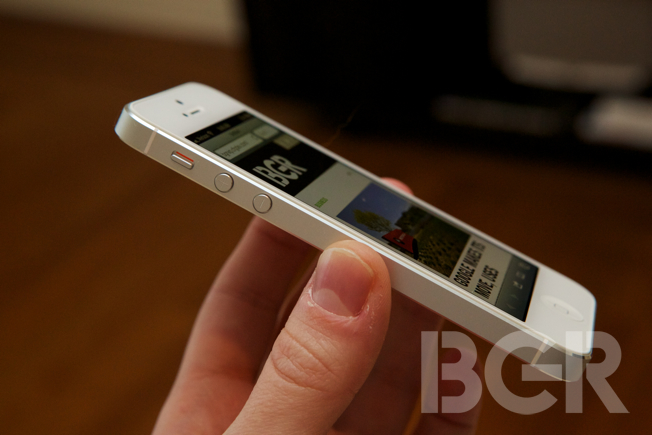
Instead of a stainless steel mid-frame sandwiched between two pieces of glass, the iPhone 5 now is made out of aluminum, just like Apple notebooks or desktops, and this does a number of things for the iPhone. For one, it makes the entire device stronger. Instead of having a solid piece of glass on the front and back, there's now just glass on the front. Instead of both of these glass slabs being attached to the front and back separately, now the phone's case is made out of one piece of aluminum, with the front display sitting flush in the iPhone. You can instantly feel just how solid and well built the iPhone 5 is the first time you pick it up.
There are also some more design elements that make the iPhone 5 truly unique. One thing that is just so amazing to me is the chamfered edge on the antenna that runs around the sides of the phone, and it's especially noticeable on the white model. These polished metal accents really put the phone over the top in the looks department — it's reminiscent of the detail put into a high-end timepiece.
Apple used to have the headphone jack on the top of every iPhone, but in the iPhone 5 it's now moved to the bottom. I'm not in love with this move conceptually, but I really haven't used headphones yet on the iPhone to comment on actual usage. In general, it doesn't feel right because if you ever put your iPhone into something standing up while working out, like a cup holder, or even in your pocket, the phone is now going to be upside down when you take it out. It's not a huge issue, but it's not ideal. By moving the headphone jack to the bottom, Apple was able to make the phone thinner, so if that's the tradeoff, I'm certainly ok with that.
Another design change comes in the form of Apple's new connector called "Lightning," and this connector is incredibly small. It's smaller than a microUSB connector, and offers a number of advantages over the older 30-pin dock connector used on every Apple iPod, iPhone and iPad. It's reversible, it won't break as often, it's future-proof, and above all, it needed to be done.
There were two physical reasons iPhones couldn't get thinner (leaving out battery, or components, or anything like that) in the past: the headphone jack, and the dock connector. By making the dock connector smaller — not just on the case, but the actual component in the iPhone as well — Apple has started to move to make its devices much thinner. It's safe to say that down the road, there's a very good chance the headphone jack will go as well, allowing Apple to make its designs even thinner, obviously alongside advancements in the components and screen technology department.

If you wish to continue using your current iPhone cables and accessories, Apple is making an adapter cable that is basically an extension cord for your current cable with a Lightning connector on the end. The company also makes an actual adapter. These are pretty pricey at $30 each, and comically aren't even available yet to purchase at most stores, or from Apple directly.
The last few changes on the iPhone 5 would be the new nano-SIM card slot, which introduces in a whole new SIM card once again, two small pieces of glass on the top and bottom of the back of the iPhone for the cellular, Bluetooth, Wi-Fi antennas, and upgraded microphones and speakers.
The new speakers on the iPhone 5 are amazing. They are crystal clear, and they project insanely well. They don't just get loud, they get loud without distortion. Apple's new trio of microphones — yes, there are now three microphones on the iPhone 5 — really help with noise cancellation, and it also helps when you're recording a video since your phone's back is pointed to the subject, not the microphone you talk into when you're on the phone.
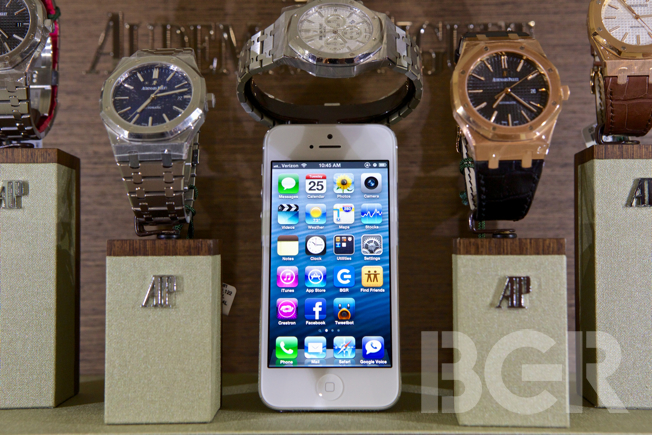
Let's turn the iPhone 5 on for the first time.
The first word out of my mouth — well, to myself — was wow. The display isn't drastically different from the already great iPhone 4 and 4S display, but at the same time, it is. Once you look at the colors on this panel, there's no going back. I have not ever seen colors so lifelike on a mobile device. The color reproduction on the iPhone 5's display is insane, and it's something that makes the entire phone feel even further ahead of any other competitor.
There are a number of reasons for this. First, the display itself is better, but how it's manufactured is also important. When you use a touch screen device, there is the display like an LCD that is the screen, and there's a layer on top called a digitizer. This converts your touches into data that lets the phone know what you tapped, and how to react. Apple has integrated this touch-sensing layer into the display itself, which not only makes the entire front panel thinner, but also clearer. Now the screen sits just under the glass that covers the front of the iPhone — which is also thinner — and it's not blocked by anything but you when you use it. It's a huge change that won't be appreciated by most users, but the difference it tremendous.
Apple's sixth iPhone is still just as responsive, but the 16:9 aspect ratio of the new 4-inch display is a big change from earlier models. I haven't been using the iPhone 5 for more than a few days, but I'm not 100% sold on it yet. I realize this display is here to stay, but here are my initial frustrations with it...
First off, the 16:9 aspect ratio in general isn't something I have ever liked on a mobile device. It's why the iPad's 4:3 ratio is so perfect — it's more like a piece of paper then a skinny and tall widescreen display, and it's more natural. That was the same for the iPhone. Now, in portrait mode, nothing has changed too much. You get more screen space, everything is great. In landscape, however, it just feels a little unnatural. Maybe I have not spent enough time with the new display, but I'm not in love with the 4-inch and 16:9 dimensions just yet.
Using the phone with one hand, the one thing that was so perfect on the iPhones before, is also more challenging now. It's not at insanity levels like on Android smartphones, but it's a tad bit tougher.
You sometimes need to lightly adjust the phone's position in your hand when you hold it in order to reach something at the very top corner of bottom corner, and I'm not kidding, my thumb hurt after the first day because I was straining to reach certain things. I get the competitive need for a larger display especially when there are 5.8-inch smartphones on the market, and 4.3-inch ones seem to be the absolute base-point, but I still feel like Apple strayed from its vision of the ideal smartphone here, away from the perfected 3.5-inch display. Let's see if my opinion changes at all over the next couple days — it has made a difference for some other people who have used the phone for longer than a few days, but I'm not completely sold just yet.
As far as the actual experience of using the iPhone 5 and how different it is compared to the iPhone 4S, it really boils down to this: Apple says that the new iPhone 5 is twice as fast as the iPhone 4S, and I agree.
The difference is immediately noticeable, and it's even more pronounced when you use the phone for a day straight. Apps launch instantly, web pages appear instantly, photos save instantly... it is just all a better experience.
There are a number of reasons the phone is faster, but one of them is the fact that Apple has introduced a new processor that was designed completely in-house, and it's — you guessed it! — twice as fast as the one running in the iPhone 4S. Gameplay is also drastically enhanced with up to three times better graphics performance. This enables the iPhone 5 to run console-quality games in the palm of your hand, and while most games that need to be updated for the iPhone 5's hardware aren't yet available, gaming is going to be a major focus for a lot of developers on the new iPhone.
Speed isn't just related to the iPhone's processor. There are two other very important upgrades in the iPhone 5, and the first is Wi-Fi.
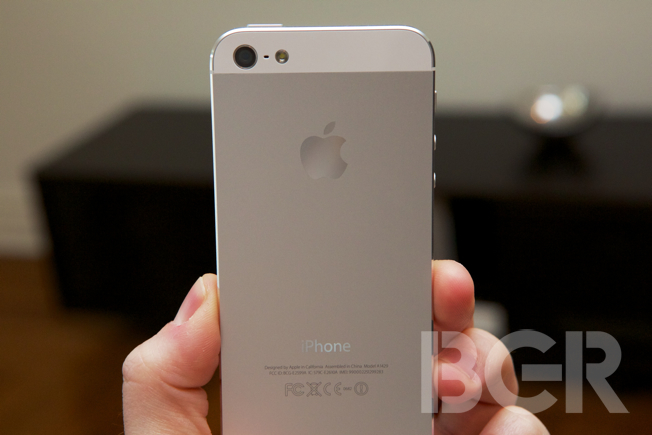
Apple has finally included Wi-Fi N support in the iPhone 5, and this allows you to connect to super-fast wireless 5GHz networks for speeds of up to 150Mbps. That's a big deal, especially for all of the ways we use our mobile devices. Videos will load instantly, syncing to iTunes wirelessly will be twice as fast, downloading apps, loading webpages — you name it — all faster. In my house I used to get around 20Mbps on my iPhone 4S over Wi-Fi. On the new iPhone I get north of 50Mbps. This also enables better range, so you can connect to more access points from even further away.
The second major speed upgrade in the iPhone 5 is 4G LTE.
While competitors have had 4G LTE in their smartphones for more than a year, Apple waited for a number of reasons, and LTE is complicated. The way 4G LTE used to work was that it required a phone to literally run two wireless chips, one for the slower networks and one for LTE. This resulted in thick, heavy smartphones with terrible battery life.
Apple's approach is very different. It combined all of these wireless radios into one single chip, letting the iPhone work on a dizzying number of cellular networks across the globe — the iPhone 5 supports GSM/GPRS/EDGE/CDMA/EV-DO/WCDMA/UMTS/LTE. It also supports no fewer than 10 wireless bands. This means that the iPhone 5 is a true global device, able to roam anywhere in the world, on practically any network.
One important thing to keep in mind about LTE is that since it's so new, there are a couple limitations with roaming. If you buy an AT&T iPhone 5, your iPhone will only work on LTE on AT&T in the U.S. and on LTE in Canada. If you buy a Verizon iPhone 5, it will work on Verizon LTE in the U.S. and also on networks in Europe and Asia, but not in Canada. Both phones will work on 3G on any country. In fact, the Verizon iPhone 5 is unlocked so users will be able to even use it on AT&T's 3G network in the U.S. if they wanted to for some reason, but it makes for a great travel phone if you like using local SIM cards while abroad.
Enough about the LTE specificities though... how does it work?
Well, Apple actually has some LTE experience because it's built into the latest iPad. The iPad doesn't have battery issues, in fact, it's the best performing LTE device I have ever used. So what about the iPhone 5? You guessed it, it's the same. There is no noticeable battery life hit coming from an iPhone 4S, and when you think about what Apple has done with the iPhone 5, it's completely astonishing. Twice the speed, twice the memory, three times the graphics performance, a bigger display, and 4G LTE all don't dent the battery. I have been using a Verizon Wireless (VZ) iPhone 5 as well as an AT&T (T) model, and they have both performed admirably.
In fact, the AT&T iPhone 5 surprised me the most because I have used Verizon's LTE on my iPad and haven't had as much experience with AT&T's besides the occasional Android phone here and there. Travelling from Connecticut to midtown New York City, and back to Connecticut, I was on LTE practically the entire way, and the entire time on LTE, it was rock solid. I actually haven't had that good of an AT&T data experience in quite a long time, probably not since the EDGE days on my Treo 650 travelling the same exact route. Verizon's LTE performed just as it does on my iPad — perfectly.
I saw speeds of up to 55Mbps on AT&T's LTE and speeds of up to 29Mbps on Verizon's LTE; there is one main difference between these networks and it has to do with congestion. AT&T's LTE network is not as built out as Verizon's and it has less users. Over time, I believe they should give or take be about equal, so I wouldn't choose one over the other right now based on speed. Coverage favors Verizon with the company reaching over 370 cities and almost 90% of the country's population. AT&T covers 75 cities right now and the carrier plans to cover an additional 25 by the end of this year, bringing LTE to 100 cities in 2012.
So, you pick your favorite carrier, or your soon-to-be favorite carrier, there's LTE coverage where you live and work, it's as simple as that. Almost. There is one limitation of LTE and it sways in AT&T's favor. It has to do with simultaneous voice and data usage, or the ability to check your email, driving directions, or bring up a webpage while you're on the phone.
Since Verizon's network before LTE was based on CDMA, it never supported voice and data at the same time. AT&T's 3G network has. To complicate things further, LTE doesn't currently support voice calls, just data. What happens if you get a call while using LTE on AT&T? The LTE session pauses and you drop down to 3G for voice and data until you hang up, at which point LTE resumes.
The same thing happens on Verizon, but when the LTE session is paused, you get dropped down to CDMA (this is Verizon's tried and true network that reaches practically the entire country, and the one that people swear by), but when you're on CDMA for your phone call, you can't use data just like any current iPhone user on Verizon knows. Not a crisis either way, but something to keep in mind.
What about using the new iPhone as an actual phone? This has historically been the number one issue with the iPhone in my book, and a lot of others feel the same way. Some issues were network related, but some were hardware related, too.
The iPhone 5 is the best performing mobile phone Apple has ever built. It gets incredible reception, getting service when other phones can't, and calls finally sound good. They sound good talking on the phone, and they sound good to other people when you're talking to them on the other line. Noise cancellation works very well, and Apple has finally included noise cancellation in the ear speaker that you put up to your ear, which helps drown out any background noise so you hear the caller more clearly. Speakerphone also sounds much better and clearer, something that wasn't always great in previous iPhones.
I touched on battery life above, but just to drive it home, the iPhone 5 performs just as well as the iPhone 4S before it in every single department. Watching movies, browsing the web over cellular networks, browsing the web over Wi-Fi, playing games, using apps, sending email, and so on. In fact, there are two areas of the battery that aren't just as good as the iPhone 4S, they are better. For phone calls made over 3G, Apple says you get an extra two hours of battery life, and for web browsing over 3G, you get one extra hour of battery life. I have found that to be true and also noticed slightly better than reported standby time as well.
If you thought we were done, you'd be mistaken. There are a few more upgrades to the iPhone 5, and the new cameras definitely shine on Apple's iPhone 5. Apple has included a 720p front-facing camera for photos and video calls, and it's a big upgrade. Apple calls it a FaceTime HD camera, and it's the same one used on the company's latest computers. It makes a remarkable difference to finally have a high-resolution front-facing camera for FaceTime.
On the back, Apple has introduced a number of camera enhancements. For starters, now a sapphire crystal lens is used to protect the camera from any scratches when you place your iPhone down, and Apple has made the processing of the camera's photos and movies even better. Photos are captured almost 50% faster than before, so the photo is saved almost instantly as you press the shutter button. There are also improved camera features like a wonderful panorama mode. In fact, while there are a number of panorama apps available for the iPhone, Apple's implementation is one of, if not, the best. It's so easy to use and lets you capture incredible photos that are seamlessly stitched together.
Some more improvements include a much better low-light mode, so photos you take at night or in dimly lit locations look way better. There's also better motion stabilization when you're taking 1080p video on the phone, making your captured footage much less shaky. You can take photos while you're recording a movie now as well. Lastly, there is that extra microphone on the back next to the camera that provides better audio for your movies than before. Overall, the camera takes better photos and better movies than before. Also of note: panorama is available as part of the free iOS 6 update for the iPhone 4S.
Speaking of iOS 6... it's an interesting update for Apple. Be sure to check out our full review of iOS 6, but to me, it feels as if it's about refinement not just because Apple didn't want to include some new features in the past that we all would have wanted, but because it's about Apple setting the stage for an even bigger release next year. The OS is smoother, it runs faster, all of the stores have been redone including the App Store and the iTunes store, there are new music players, Apple ID merging so you can use both your phone number and Apple ID on all of your devices (including your computer), way better Siri functions, full-screen Safari, multiple email signatures for accounts, and yeah, a controversial new Maps app. Let's jump into that.
Using the iOS 6 operating system since June, I saw the progress Apple made with Maps since the beginning. In just a couple months, the app's data has dramatically improved as more points of interest were added, more 3D cities were added, more street names and other data was flushed out, and more.
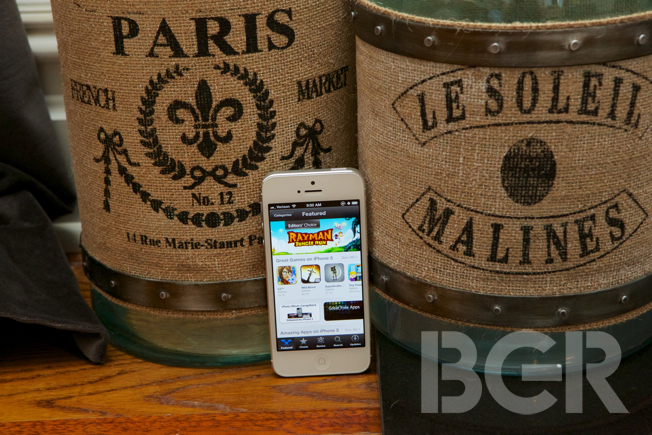
There are a couple advantages to Apple's maps, and a couple disadvantages compared to the previous Maps app, which was powered by Google.
Apple's vector-based maps are beautiful and they work way better than the previous maps application, and the 3D views that Apple has included are breathtaking. Apple's turn-by-turn directions are also much better than turn-by-turn directions that Google provides on Android smartphones in my opinion. You can use them when your phone is locked, and if you're in another app while you're getting directions, your next turn will show as a notification on the top of the screen so you don't miss it. I also really like the fact that Yelp is integrated as well, because it provides not only ratings for restaurants and businesses, but also photos and even business hours.
The downside is that Apple's mapping efforts aren't nearly as mature as Google's, and Apple has replaced Google's with its own. This means anyone updating to iOS 6 will instantly see that Google maps has now been removed and replaced with Apple's app. That can be frustrating if you relied on a couple things Google Maps provided which Apple does not.
Gone are the public transit directions that many relied on, and most importantly, accuracy. Google Maps isn't always perfect, but there was a level of data and information that isn't there any longer with the Apple-developed Maps app. Apple's app may look and work better, but with less data and information, it's less useful. The good news is that Apple knows this, and the more its customers use Maps, the better and better it will become.
A standout feature for me in Maps has been traffic. Apple is not only gathering real-time traffic data from multiple data sources like TomTom and Waze, but it's also anonymously gathering it from other iPhones in a true crowd-sourced fashion. This not only provides reliable traffic information, but also reasons for slow traffic, like accidents of roadwork on the new Maps app.
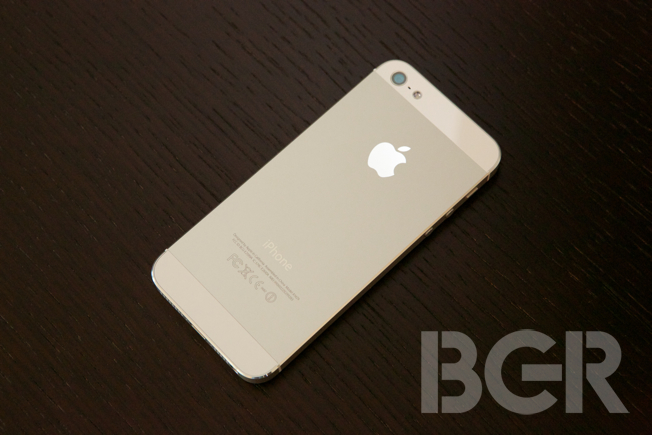
There are over 200 new features in iOS 6 according to Apple, way too many to cover, and there isn't a single reason to avoid updating your iPhone 3GS, iPhone 4, iPhone 4S, iPad 2, new iPad, or fourth-generation iPod touch to iOS 6.
As you have read, just about every single thing Apple could have improved from the iPhone 4S has been improved. It's about refining these different building blocks that make up a smartphone, and Apple has done that in spades — thinness, lightness, materials, durability, design, performance, speed and experience.
Apple's iPhone represents more than sheet of specifications of processor speed, memory and screen inches, it represents the best of the best, refined every year, only like Apple can. The best screen, the best camera, the best materials, the best design, the best fit and finish, the lightest, the strongest, the thinnest, the fastest, the most well thought-out, and the best user experience of any mobile phone in the world... This is the new iPhone.
There's still nothing like an iPhone, and the iPhone 5 solidifies Apple's dominance in the smartphone industry.
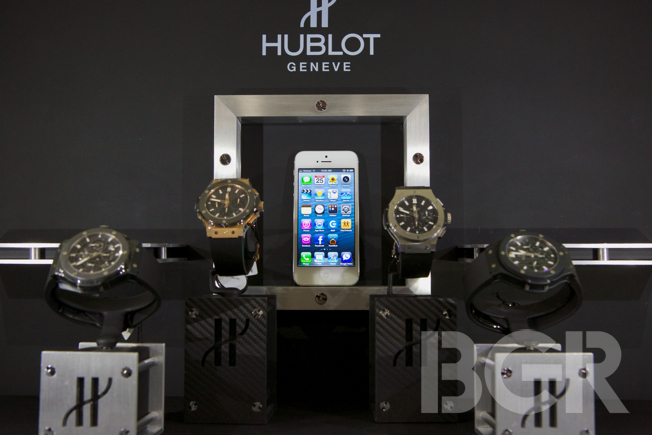
Special thanks to Manfredi in Greenwich.
